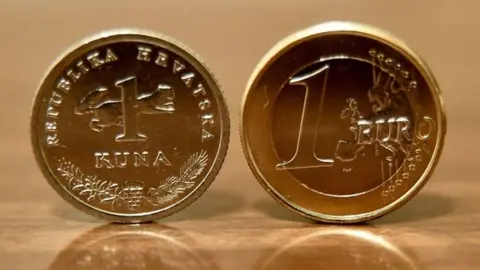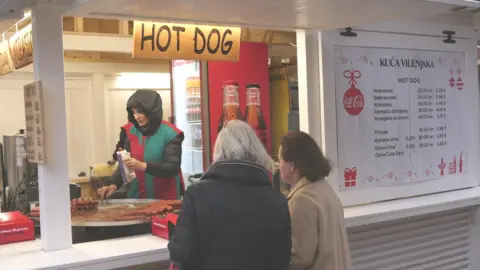Croatia, the euro and a coffee controversy - but is it all just froth?
 Guy De Launey
Guy De LauneyOnly the very brave - or the very foolish - would dare to come between a Croatian and their coffee.
Stroll the streets of the capital Zagreb, and even in the winter months you will find the pavement cafés crowded with cappuccino-quaffing locals.
But early in the New Year, some have been finding that their favourite beverage now comes with a bitter aftertaste.
Croatia adopted the euro as its currency on 1 January, a decade after it became the European Union's newest - and still most recent - member.
And the switch from the kuna has left many Croatians convinced that cafés, as well as retailers and service providers, are taking advantage by hiking their prices.
The local media has been full of gripes about price-gouging since the start of the year. And a straw poll of punters in Zagreb's main square confirms the consternation.
"It's very confusing," says Vina as her friends Monika and Tonka nod in agreement. "It looks cheaper but it's actually really expensive. We just paid six euros for two coffees and a cola - I was shocked."
 Guy De Launey
Guy De LauneyAnother local, Zivana, feels much the same way. "All these price rises started in June," she says. "Now it's in the spotlight and it's even worse. We're not happy with the government and the way they've handled the situation."
The controversy has been raging so fiercely that Croatia's government felt it had to intervene.
It called retailers into meetings to warn them that it would not tolerate unjustified price hikes. The businesses declared themselves outraged by the government besmirching their reputation.
But the authorities clearly felt they could not afford to have the euro become synonymous with stealthy profiteering. The government ordered retailers to ensure prices were no higher than their level on 31 December.
 Getty Images
Getty ImagesState inspectors pounced on transgressors, filing cases against almost 200 recalcitrant retailers in the space of a week.
There are, of course, those who feel that the great Croatian coffee controversy is just so much froth. As he works the espresso machine in a bar on Zagreb's bustling Flower Square, barman Luka says he suspects that people are getting steamed up over nothing.
"We had our prices displayed in euro before the euro came in," he says. "Now they say we're too expensive - but it's the same price as it was before the New Year."
With all the noise about price hikes - whether real or imagined - it would be easy to forget why Croatia chose to join the eurozone. In fact, it was committed to membership of the single currency as a condition of joining the EU in 2013.

Global Trade

Other member states have shown that commitment is one thing, but actually adopting the euro is another matter entirely. Croatia's neighbour Hungary originally had a plan to scrap the forint in 2007. But 16 years later, it remains firmly outside the eurozone.
Poland, Romania, Sweden and the Czech Republic are all theoretically obliged to adopt the euro. But none have plans to do so. Only Bulgaria seems set to join the single currency in 2024.
It makes Croatia's determination to meet the euro's convergence criteria seem all the more impressive. It reflects the stability of numerous factors - inflation in the country, the government's budget deficit, the nation's debt-to-GDP ratio, and its long-term interest rates since joining the EU.
Exchange rate stability was virtually a given, bearing in mind that on the creation of its national currency in 1994, Croatia pegged the kuna to the Deutsche mark. A euro peg then followed.
The governor of Croatia's National Bank, Boris Vujcic, says all this meant that his country, its businesses and its people were exceedingly well prepared for the adoption of the single currency.
 Guy De Launey
Guy De Launey"Croatia was already heavily euroised," notes Mr Vujcic. "Corporate, government and household debts were already denominated in euros or linked to euros. Now all the income is in the same currency as the debts."
Far from causing price increases, Croatia's chief banker believes that committing to the single currency spared the country from the worst of the inflation that has struck countries outside the eurozone over the past year.
"You can see the impact of the crisis was much less severe in Croatia's case, because markets already priced in the fact that we were getting into the eurozone," says Mr Vujcic.
Now Croatian businesses are looking forward to a boost from the euro, combined with the fact that the adoption of the single currency has coincided with Croatia's membership of the borderless Schengen Area.
The latter makes life significantly easier for European tourists arriving in the country by car or coach, as they will no longer have to face interminable queues at border crossings. And euro adoption means visitors won't have to dice with dodgy exchange rates at a hole-in-the-wall bureau de change.
As a result, Croatia's tourism industry, which contributes around a fifth of Croatia's GDP, is expected to get a boost.
 Guy De Launey
Guy De LauneyDubravko Miholic, an adviser to the Croatian National Tourist Board, has been following comments on travel websites in the countries that send the most holidaymakers, such as Germany and Austria. "They're saying it's great, finally we won't need to change money," he says.
The experts also predict a boon for Croatia's exporters, with the single currency eliminating the last remaining source of friction in cross-border trade within the EU.
"In less than a decade of EU membership, we've seen the export of goods more than double," says Goran Saravanja, chief economist of the Croatian Chamber of Commerce. "Now, companies outside the euro area who are thinking of locating in Europe are looking at 20 countries, rather than 19.
"We're already good at logistics because of our geography. Now without the additional costs, thanks to Schengen and the euro, there's an impetus there."
 Guy De Launey
Guy De LauneyIf the predictions are correct, the benefits should become clear in the next few years. But for now Croatian consumers remain more concerned about taking a hit to the pocket as they get used to carrying the new currency.
They can no longer spend the kuna. But retailers must still display prices in old money until the end of the year, to reassure customers that while the denomination may have changed, the value remains the same.
